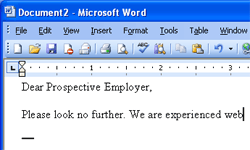Let's say you're a freelance web designer, and you come across a project description for, say, the redesign of a little site that lets you
host web meetings. This could be your ticket to fame and fortune. But how should you proceed? Well, frankly, you could have proceeded in just about any moderately professional way imaginable last week and scored that gig, but instead you did the following. All 200 of you.

Solid Gold!!!
1.
Send out a Canned Proposal. And not just any canned proposal, send a giant letter filled with the entire contents of your website, but without the proofreading. Make sure it reads like a long-form sales letter, complete with opening phrases such as "Webmaster, your search is over! We're just the candidate for you!!!", but with more exclamation points. Be sure to include links to at least 500 websites that you may have been remotely involved with.
2.
Send that Canned Proposal within the first 20 minutes, because time is of the essence. You want to make the statement that "I Didn't Give This Any Thought At All!" And you want to make that statement fast. Good employers tend to hand out knowledge work on a first-come, first-served basis, so you want to make sure you end up on top of the stack. Extra credit for sending the same bid twice!
3.
Don't Read the Project Description, or visit the site you're expected to be writing a proposal for. Bid on pieces that weren't up for bid. Ignore the direct questions asked of you in the project description.
Honorable mention:
To the guy in Florida who tallied up his hours, then tacked on the 5% overhead that this particular freelance site charges (expected to be borne by the freelancer, not the employer), then made a point of demanding payment up front. Good way to break the ice and build confidence.
4.
Don't, under any circumstances, write any text specific to the project at hand. If you somehow feel obligated to write a sentence or two to show how much thought you've put into your proposal, be sure to tack it on to the bottom. After your cheesy promo text, after that list of 50 links to your class projects, and after that special offer of a 20% discount if I ACT NOW because it's your Fall Sale!
5.
Quote an exact dollar figure, after having completed the steps above. This is a nice final touch, as it shows that even though you didn't bother to skim through the project description before sending off your automated response, you still have a firm grasp on our needs.
How to do it right:
Freelancing on Guru, Elance, Rentacoder, etc. is all about first impressions. Your prospective client will no doubt be swamped with dozens if not hundreds of proposals, and you need to find a way to make yours stand out. This is surprisingly easy to do in the current climate, as even the slightest hint of professionalism will do it. Your competition is all trying to shout over the top of each other, thinking that's how you get heard. But you know what? Shouting "I'm an Idiot" at the top of your lungs may in fact get you heard, but it won't usually get you hired.
So here's what you need to do if you actually want to hear back from a potential client: Write a simple, three paragraph proposal, from scratch. Spend the whole first paragraph summarizing the project and explaining why it's something you're good at. Go over your planned approach in the second paragraph, and end it with a ballpark estimate if the project description gave you enough information to do so. And finally, wrap up with a little pleasantry, and give the client a way of learning more about your operation and contacting you if they want to proceed.
Sounds simple, eh? Well, I used to do a lot of freelancing, and got a lot of work with that approach. Trust me, nobody else is doing it. Behave like a professional, and you'll clean up!
by
Jason Kester
 Discuss on hacker news
Discuss on hacker news